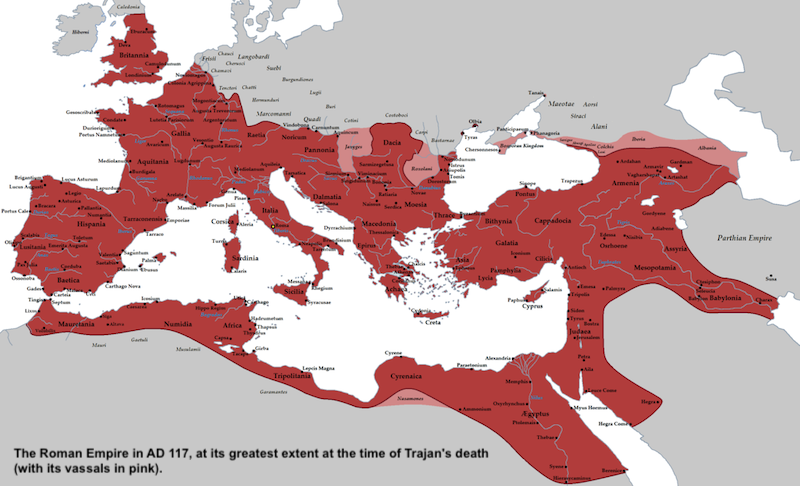Rome after the Flavian dynasty and Its Ultimate Collapse
Episode #10 of the course The mad world of the Roman emperors by James Wareing
Our final lesson will go over what became of the Roman empire after the eight emperors that we have learned about on this course. This will take us on a quick tour through the final 400 years of the Roman empire, right up until its fall, and give an insight into some of the lesser known parts of Roman history.
After the death of Domitian, the Flavian dynasty came to an end. However, unlike the previous succession struggles that mired the year after the end of the Julio-Claudian dynasty, Rome experienced a period of prosperity after Domitian that lasted for the next century. In fact, the next five emperors were nicknamed the “five good emperors” (Nerva, Trajan, Hadrian, Antoninus Pius, and Marcus Aurelius) as the Roman Empire grew larger, stronger, and probably to its peak. Hadrian in AD 122 strove to separate Rome’s boundaries from barbarians and in doing so, built a wall stretching across the north of England, the northernmost point of the empire, some of which still stands today.
Back to the Customary Chaos
After a period of relative peace, Rome returned to the chaos that had come to be associated with its emperors. There was the year of the five emperors between AD 192 and 193 that included a fratricide, the usual assassinations, and wars that proved costly and largely ineffective across the north of Africa. There was also a prominent lady by the name of Julia Mesa, who was among the few influential women of the early third century. Such was her power that the emperor Macrinus exiled her. However, this move backfired, as while in exile, she organized a coup that overcame Macrinus and made Julia’s grandson, Elagabalus, emperor of Rome. So well respected was she that upon her death, she was deified.
The late third century was marred by violence and civil war that threatened to split up the Roman empire. The economy was hit hard as a result, which led to many public protests and revolts. The empire did temporarily break up into three parts before being brought back together by Aurelian. However, by this point, the management of such a vast area of land and disparate range of people was proving nigh-on impossible. Diocletian’s solution was to divide the empire into two, a western and eastern half, which served for a brief period of time to establish a period of stability for the empire.
Christianity Comes to Rome
In AD 317, Rome, which had until then believed in the Roman gods, of whom Jupiter was the king, welcomed Christianity after the emperor Constantine attributed his victory that led to him becoming emperor to Jesus. Rome had, since the time of Jesus, persecuted the Christians on an unforgiving and unrelenting basis. Constantine’s subsequent support of Christianity also led to freedom of religion for all, leading to more religious tolerance. He moved the Roman capital to Constantinople (Greek for “City of Constantine”), which had previously been called Byzantium and is now Istanbul.
The End of the Empire
In late AD 476, the Roman empire of Western Europe was conquered by Germanic tribes. While the Eastern empire remained until 1453, the collapse of the Western Empire sparked a period often referred to as the dark ages. Literature and all the other hallmarks of sophisticated society that had come to be associated with the Roman Empire stalled, and a period of stagnation set in.
The fall of the empire brings us to the end of the course. What this demonstrated as much as anything was the remarkable achievements of the Roman empire due to, and sometimes in spite of, their eccentric rulers. What is also striking is how intrinsic to human nature and power many of the attributes to the Roman emperors are. Today, we see tyrants ruling countries, cracking down on dissenters in brutal fashion, and ambitious individuals engineering their way to power. The Roman emperors, therefore, in both their characteristics and their achievements, have had a lasting impact on society.
Learn Something New Every Day
Get smarter with 10-day courses delivered in easy-to-digest emails every morning. Join over 400,000 lifelong learners today!
Recommended book
SPQR: A History of Ancient Rome by Mary Beard
Share with friends

